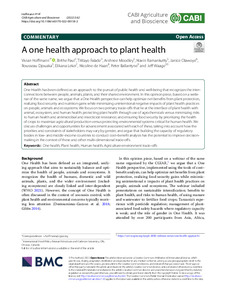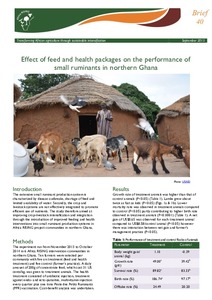| dc.contributor.author | Hoffmann, V. |
| dc.contributor.author | Paul, B. |
| dc.contributor.author | Falade, T.D.O. |
| dc.contributor.author | Moodley, A. |
| dc.contributor.author | Ramankutty, N. |
| dc.contributor.author | Olawoye, J. |
| dc.contributor.author | Djouaka, R.F. |
| dc.contributor.author | Lekei, E. |
| dc.contributor.author | De Haan, N. |
| dc.contributor.author | Ballantyne, P. |
| dc.contributor.author | Waage, J. |
| dc.date.accessioned | 2022-10-25T14:20:42Z |
| dc.date.available | 2022-10-25T14:20:42Z |
| dc.date.issued | 2022 |
| dc.identifier.citation | Hoffmann, V., Paul, B., Falade, T.D.O., Moodley, A., Ramankutty, N., Olawoye, J., ... & Waage, J. (2022). A one health approach to plant health. CABI Agriculture and Bioscience, 3: 62, 1-7. |
| dc.identifier.issn | 2662-4044 |
| dc.identifier.uri | https://hdl.handle.net/20.500.12478/7901 |
| dc.description.abstract | One Health has been defined as an approach to the pursuit of public health and well-being that recognizes the interconnections between people, animals, plants, and their shared environment. In this opinion piece, based on a webinar of the same name, we argue that a One Health perspective can help optimize net benefits from plant protection, realizing food security and nutrition gains while minimizing unintentional negative impacts of plant health practices on people, animals and ecosystems. We focus on two primary trade-offs that lie at the interface of plant health with animal, ecosystem, and human health: protecting plant health through use of agrochemicals versus minimizing risks to human health and antimicrobial and insecticide resistance; and ensuring food security by prioritizing the health of crops to maximize agricultural production versus protecting environmental systems critical for human health. We discuss challenges and opportunities for advancement associated with each of these, taking into account how the priorities and constraints of stakeholders may vary by gender, and argue that building the capacity of regulatory bodies in low- and middle-income countries to conduct cost–benefit analysis has the potential to improve decisionmaking in the context of these and other multi-dimensional trade-offs. |
| dc.description.sponsorship | CGIAR Trust Fund |
| dc.format.extent | 1-7 |
| dc.language.iso | en |
| dc.subject | One Health Approach |
| dc.subject | Plant Health |
| dc.subject | Health |
| dc.title | A one health approach to plant health |
| dc.type | Journal Article |
| cg.contributor.crp | Agriculture for Nutrition and Health |
| cg.contributor.affiliation | International Food Policy Research Institute |
| cg.contributor.affiliation | International Center for Tropical Agriculture |
| cg.contributor.affiliation | International Institute of Tropical Agriculture |
| cg.contributor.affiliation | International Livestock Research Institute |
| cg.contributor.affiliation | University of Copenhagen |
| cg.contributor.affiliation | University of British Columbia |
| cg.contributor.affiliation | London School of Hygiene and Tropical Medicine |
| cg.coverage.hub | Headquarters and Western Africa Hub |
| cg.researchtheme | Nutrition and Human Health |
| cg.researchtheme | Social Science and Agribusiness |
| cg.identifier.bibtexciteid | HOFFMANN:2022 |
| cg.authorship.types | CGIAR and developing country institute |
| cg.iitasubject | Food Security |
| cg.iitasubject | Plant Health |
| cg.journal | CABI Agriculture and Bioscience |
| cg.notes | Open Access Article; Published online: 29 Sept 2022 |
| cg.accessibilitystatus | Open Access |
| cg.reviewstatus | Peer Review |
| cg.usagerightslicense | Creative Commons Attribution 4.0 (CC BY 0.0) |
| cg.targetaudience | Scientists |
| cg.identifier.doi | https://doi.org/10.1186/s43170-022-00118-2 |
| cg.iitaauthor.identifier | Titilayo Falade: 0000-0001-5562-7861 |
| cg.futureupdate.required | No |
| cg.identifier.issue | 62 |
| cg.identifier.volume | 3 |




